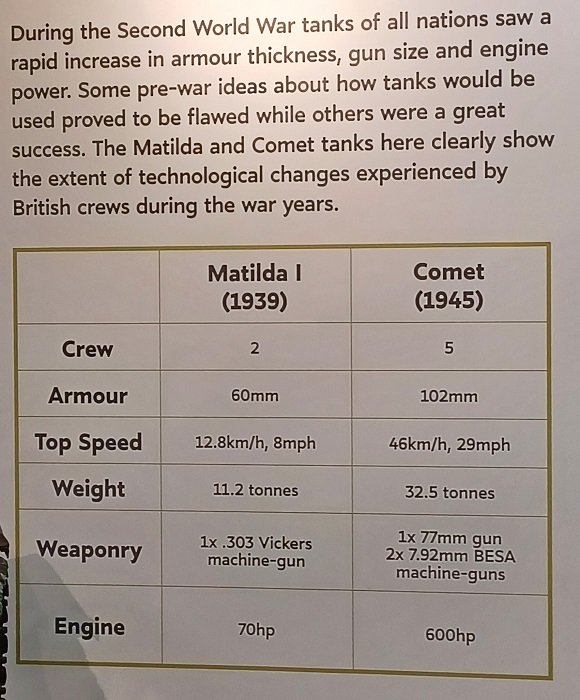The Tank Museum
The Tank Museum is based at Bovington in Dorset, which had been the main training centre for tanks in the First World War.
‘The Museum tells the story of the Royal Tank Regiment and its predecessors, and from 1939, the Royal Armoured Corps; comprising of the cavalry, the Royal Tank Regiments and certain Yeomanry units’ – from the Souvenir Guidebook.
We’d been to the Tank Museum once before, when the boys were much younger, with our homeschool group.
As with so many other things, we’d planned on going back but never got around to it.
Last week’s visit, mainly to watch Sabaton’s ‘The War To End All Wars’, reignited our interest.
The first thing we did was go to the screening, after which we found ourselves in the Second World War section as that was where the screening room was situated.
As we were busy talking about the film, we didn’t really pay attention to the layout, so began looking at the tanks that fought in World War 2.
Which meant we ended up doing things a little back to front and only realised when we came out of that section.
T-34/85 - Soviet tank
Jagdpanther - German tank
M4A1 Sherman - American tank
Sherman Crab Mark 1 - UK
This is from the explanation board at the front of the tank:
‘The creation of the flail tank allowed soldiers to clear minefields quickly whilst the crew inside were protected by the tank’s armour. The drum rotated three times per second, meaning the chains would thrash the ground with enough force to set off buried mines. This was still a risky job for the crew – they had to drive at walking speed in a straight line, with the dirt kicked up making it impossible to see or shoot.’
Panzer IV - German tank
‘Little Audrey’ china doll
This little china doll took us by surprise, displayed amongst the tanks. She’d been given to Bill Bellamy of the Royal Armoured Corps by his girlfriend, Audrey, as a good luck charm, his mascot. The troop adopted the doll and their tank, the ‘Abbot of Chantry’ became known as ‘Little Audrey, Abbess of Chantry’.
It’s amazing how good the doll still looks – according to the explanation board, she’d been knocked off the tank as Bellamy and his men prepared to go into battle in Holland; one of the men in a tank behind Bellamy’s leapt out of his tank, ‘rescued’ her from the hedgerow and handed the doll back to Bellamy, shouting, “I’m not going without her!” before returning to his tank.
The Bellamy family has allowed the Tank Museum to display the doll, making her quite unique as she’s the only Second World War mascot in the collection.
A9 Cruiser - British tank
The Home Front, modelled after the town of Bovington during the Second World War
Rolls Royce armoured car
Side view of the Rolls Royce armoured car - according to the note on the side, the car is over 100 years old
Showing the development of the tank in the UK from 1939 with Matilda (L) to 1945 and Comet
Comparison table for Matilda I and the Comet
Then we went to ‘The Trench Experience’ about the First World War, which continued to ‘Warhorse to Horsepower’.
Recruitment officer - a recorded voiceover plays with the officer addressing a potential recruit
The Trench Experience
Leading into the trenches
‘Soldier’ manning the trench
The Mark I - British tank - front view of the full scale diorama showing the tank approaching a trench
The Mark I - this is the only surviving Mark I tank anywhere in the world
Rear detail of the full scale Mark I diorama
Vickers 8B2/M, motorcycle machine-gun combination of the British Army
The machine-gun and gunner’s seat
1st Reserve Regiment of Cavalry in training, Aldershot 1914
Although there was an actual Lee-Enfield rifle on display, I didn’t take a photo of it as it was secured to a fixed housing on the floor in a corner, making it awkward to get a good photograph.
But the housing has enough wiggle-room to allow visitors to lift it enough to get an idea of the weight of the rifle; all 3 of us were not prepared for how heavy it actually is.
Looking at this image of cavalry in training, with the men holding the rifle in one hand and having to control the horse with the other, only increases my respect for them.
These images are part of the ‘Warhorse’ section
Transporting horses to Europe, a difficult, dangerous undertaking
Showing how few horses survived the war, the caption on the board reads: ‘From approximately 1 million horses used in the British Army during the war, only 60 000 (6 in 100) made it back home. The rest were either killed or sold locally.’
On the way out of the main museum area leading to the shop, there’s a very detailed brick model diorama in a glass cabinet; this is just a part of it:
Brick models starting on land…
… then the air…
… and ending in the sea.
We didn’t go around the whole museum as – fingers crossed – we’re planning on returning in the spring of next year when we’ll be able to see the tanks in action and how armoured vehicles work together in battle.
Another event is something called TANKFEST that takes place over 3 days in the summer – I think it’s something that’s held every summer – and features ‘arena action, with explosive displays of unique historic and modern armour…’
That certainly sounds like something worth going for… shall give it some thought.





























